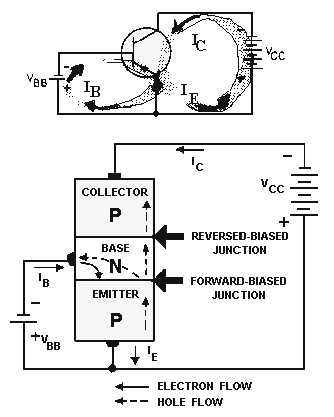2-15
Figure 2-11.—PNP transistor operation.
Although current flow in the external circuit of the PNP transistor is opposite in direction to that of the
NPN transistor, the majority carriers always flow from the emitter to the collector. This flow of majority
carriers also results in the formation of two individual current loops within each transistor. One loop is the
base-current path, and the other loop is the collector-current path. The combination of the current in both of
these loops (IB + IC) results in total transistor current (IE). The most important thing to remember about the
two different types of transistors is that the emitter-base voltage of the PNP transistor has the same
controlling effect on collector current as that of the NPN transistor. In simple terms, increasing the forward-
bias voltage of a transistor reduces the emitter-base junction barrier. This action allows more carriers to
reach the collector, causing an increase in current flow from the emitter to the collector and through the
external circuit. Conversely, a decrease in the forward-bias voltage reduces collector current.
Q10. What are the majority current carriers in a PNP transistor?
Q11. What is the relationship between the polarity of the voltage applied to the PNP transistor and that
applied to the NPN transistor?
Q12. What is the letter designation for base current?
Q13. Name the two current loops in a transistor.
THE BASIC TRANSISTOR AMPLIFIER
In the preceding pages we explained the internal workings of the transistor and introduced new terms,
such as emitter, base, and collector. Since you should be familiar by now with all of the new terms

